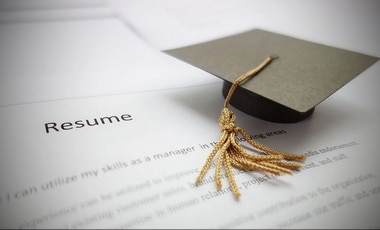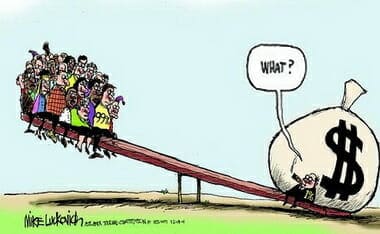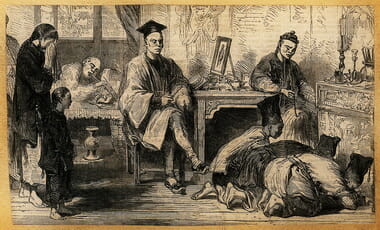Armstrong and Getty read from the Wall Street Journal about Ukraine’s success in fighting a more tech-savvy war. Pretty interesting.
Here is the WSJ article, but unlocked:
Ukraine’s Asymmetric War — Moscow has more firepower, but Kyiv is using digital technology better.
Reports from Ukraine are filled with stories of Javelin antitank missiles and Turkish Bayraktar TB2 unmanned aerial vehicles taking out Russian tanks and armored vehicles. The Biden administration has announced $800 million in defensive weapons for Ukraine, including Javelins, Stinger antiaircraft weapons and Switchblade drones. More amazing is what Ukraine has also been doing on the cheap. And I don’t mean Molotov cocktails.
Wars are increasingly asymmetric—the lesser-armed side can put up a strong fight. The U.S. learned this in Iraq with insurgent use of improvised explosive devices, basically roadside bombs triggered with cellphones. Similarly, Ukraine has been deploying inexpensive, almost homemade weapons and using technology to its advantage.
The Times of London reports that Ukraine is using $2,000 commercial octocopter drones, modified with thermal imagers and antitank grenades, to find and attack Russian tanks hiding between homes in villages at night. Ukraine’s Aerorozvidka, its aerial reconnaissance team, has 50 squads of drone pilots who need solid internet connections to operate.
When the internet was cut in Syria in 2013, enterprising techies set up point-to-point Wi-Fi connections to bring internet access from across the border in Turkey. You can do this with Pringles potato-chip cans and $50 off-the-shelf Wi-Fi routers. Ukraine may be spared this ad hoc setup as
Elon Musk and his firm Starlink have donated thousands of satellite internet-access terminals to Ukraine, including to the Aerorozvidka squads, which come with warnings to camouflage the antennas. They typically cost $499 each and $99 a month for service.
Ukraine also effectively jammed Russia’s long-in-the-tooth wireless military-communication technology, which apparently uses a single-frequency channel to operate. Former Central Intelligence Agency Director
David Petraeus told CNN that Russians were then forced to use cellphones to communicate until Ukraine blocked the +7 country code for Russia and eventually took down 3G services that Russia uses for secure connections. Russian soldiers were forced to steal Ukrainian cellphones to communicate with one another. That’s no way to fight a war.
Ukraine also has taken advantage of crowdsourcing. The Journal told the story of Russian tanks that would fire on the city of Voznesensk and then back up a few hundred yards to avoid return fire. Civilians and Territorial Defense volunteers would then message the tanks’ new coordinates via the Viber social-messaging app.
The propaganda war is also being fought on the cheap, from President Volodymyr Zelensky’s Zoom call with the U.S. Congress to Ukraine’s work spreading news inside Russia. The Russians have blocked Facebook and Twitter, independent media has been shut down, and on Russian television no one is allowed to say “invasion” or “war.” But no country can completely filter and firewall real news. The Telegram and WhatsApp messaging apps encrypt their communications. Ukraine has begun using facial recognition to identify killed and captured Russian soldiers, even contacting their families and posting their photos on Telegram channels. Twitter now is using a service to disguise its origin and restore service to Russian users.
Most surprisingly, after much hype and many warnings, Russian cyberwarfare has been deemed fairly ineffective. Hours before the invasion, someone, presumably the Russians, launched a Trojan.Killdisk attack, disk-wiping malware that hit Ukrainian government and financial system computers and took down Parliament’s website. Cyberattack tracking firm Netscout called the attack “modest.” A Ukrainian newspaper then released a file with details on 120,000 Russian soldiers, including names, addresses, phone and passport numbers. Where the information came from is unknown.
But we have a hint. Ukraine is filled with smart coders, and the government set up an “IT Army of Ukraine” Telegram channel to coordinate digital attacks on Russian military digital systems. As many as 400,000 have volunteered so far. An officer of the Ukraine State Service of Special Communications said they were engaged in “cyber-resistance.” This digital flash mob has taken down Russian websites, though I doubt we will ever fully know the damage it may have inflicted. This is definitely a social-network-influenced conflict.
In the fog of war, stories and disinformation swirl. Most are impossible to verify. I’ve heard of foreign volunteers swarming to Ukraine who then post photos on Instagram. Both Facebook and Instagram strip GPS location coordinates from smartphone photos, but they allow these volunteers to tag nearby locations, potentially giving away refugees’ hiding places. These could be targeted by Russian missiles and may have been the reason the Mariupol theater was destroyed.
New technology for use in commerce often emerges after the smoke of battle clears. World War I produced tanks, field radios and improved airplanes. World War II brought radar, penicillin, nuclear power, synthetic rubber, Jeeps and even duct tape. What we are seeing in Ukraine is the asymmetric power of pervasive inexpensive commercial technology, especially citizen-empowering social networks and crowdsourcing. So far these tools have been altering the war’s outcome. Welcome to 21st-century warfare.
As Russian invasion continues, Makariv may be small in size, but it has big strategic value as it blocks Russia’s armed forces from encircling Kyiv. Ukrainian volunteer fighters use drones in the area for reconnaissance that can be used by Ukrainian artillery units to strike back.
Footage out of Ukraine shows the impressive accuracy and timing of an air-to-ground anti personnel operation by means of a quadcopter dropping a small point-detonating explosive.


















